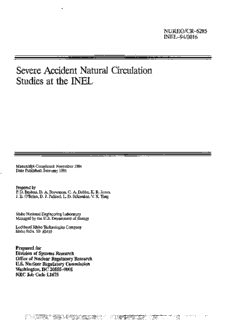Table Of ContentSevere Accident Natural Circulation
Studies at the INEL
Manuscript Completed: November 1994
Date Published: February 1995
Prepared by
P. D. Bayless, D. A. Brownson, C. A. Dobbe, K. R. Jones,
J. E. O'Brien, D. J. Pafford, L. D. Schlenker, V. X. Tung
Idaho National Engineering Laboratory
Managed by the U.S. Department of Energy
Lockheed Idaho Technologies Company
Idaho Falls, ID 83415
Prepared for
Division of Systems Research
Office of Nuclear Regulatory Research
U.S. Nuclear Regulatory Commission
Washington, DC 20555-0001
NRC Job Code L1675
DISCLAIMER
This report was prepared as an account of work sponsored
by an agency of the United States Government. Neither
the United States Government nor any agency thereof, nor
any of their employees, make any warranty, express or
implied, or assumes any legal liability or responsibility for
the accuracy, completeness, or usefulness of any
information, apparatus, product, or process disclosed, or
represents that its use would not infringe privately owned
rights. Reference herein to any specific commercial
product, process, or service by trade name, trademark,
manufacturer, or otherwise does not necessarily constitute
or imply its endorsement, recommendation, or favoring by
the United States Government or any agency thereof. The
views and opinions of authors expressed herein do not
necessarily state or reflect those of the United States
Government or any agency thereof.
DISCLAIMER
Portions of this document may be illegible
in electronic image products. Images are
produced from the best available original
document.
ABSTRACT
Severe accident natural circulation flows have been investigated at the Idaho
National Engineering Laboratory to better understand these flows and their poten
tial impacts on the progression of a pressurized water reactor severe accident.
Parameters affecting natural circulation in the reactor vessel and hot legs were
identified and ranked based on their perceived importance. Reviews of the scaling
of the 1/7-scale experiments performed by Westinghouse were undertaken.
RELAP5/MOD3 calculations of two of the experiments showed generally good
agreement between the calculated and observed behavior. Analyses of hydrogen
behavior in the reactor vessel showed that hydrogen stratification is not likely to
occur, and that an initially stratified layer of hydrogen would quickly mix with a
recirculating steam flow. An analysis of the upper plenum behavior in the Three
Mile Island, Unit 2 reactor concluded that vapor temperatures could have been sig
nificantly higher than the temperatures seen by the control rod drive lead screws,
supporting the premise that a strong natural circulation flow was likely present dur
ing the accident. SCDAP/RELAP5 calculations of a commercial pressurized water
reactor severe accident without operator actions showed that the natural circulation
flows enhance the likelihood of ex-vessel piping failures long before failure of the
reactor vessel lower head.
FIN LI675—Natural Circulation in PWRs During Severe Accidents.
NUREG/CR-6285
in
CONTENTS
ABSTRACT iii
LIST OFFIGURES vii
LIST OFTABLES vii
EXECUTIVE SUMMARY ix
ACKNOWLEDGMENTS xiii
ACRONYMS xv
1. INTRODUCTION 1
1.1 Description of Natural Circulation Flows 1
1.1.1 In-Vessel Natural Circulation 3
1.1.2 Hot Leg Countercurrent Flow 4
1.1.3 Coolant Loop Flow 7
1.2 Importance of Natural Circulation Flows 7
1.3 Description of Scenarios Leading to Natural Circulation 8
2. PHENOMENA IDENTIHCATION AND RANKING TABLES 10
2.1 In-Vessel Natural Circulation 11
2.2 Hot Leg Natural Circulation 12
2.3 Interpretation of Results 14
3. EXPERIMENTS AND SEPARATE EFFECTS ANALYSES 16
3.1 Westinghouse U-Tube Steam Generator Experiments 16
3.1.1 Experiment Description and Results 16
3.1.2 Experiment Scaling 17
3.1.3 RELAP5/MOD3 Experiment Calculations 19
3.2 Natural Circulation Flow Disruption 19
3.2.1 Upper Plenum Hydrogen Stratification and Mixing 19
3.2.2 Hydrogen Blocking of the Steam Generator Tubes 20
3.3 Natural Circulation in the TMI-2 Accident 21
4. COMMERCIAL PLANT ANALYSES 23
4.1 Surry Calculations 23
v NUREG/CR-6285
4.1.1 Modeling Natural Circulation Hows 23
4.1.2 Analysis Results 25
. 4.2 Related Plant Analyses 27
4.3 Extension of Results to Other PWRs 28
5. SUMMARY AND CONCLUSIONS 30
6. REFERENCES 31
Appendix A—Natural Circulation Parameter Importance Evaluation A-l
Appendix B—Scaling Review of the Westinghouse Test Apparatus and Natural
Circulation Experiments B-l
Appendix C—Reevaluation of Scaling Considerations for the Westinghouse 1/7-Scale
PWR Experiments C-l
Appendix D—RELAP5 Analysis of Natural Circulation Flow in the Westinghouse
High-Pressure SF6 Experiments D-l
Appendix E—Effects of Hydrogen Generation on Severe Accident Natural Circulation E-l
Appendix F—Evaluation of the Capability of RELAP5/MOD3 to Calculate Hydrogen
Blockage Effects in U-Tube Steam Generators F-l
Appendix G—Examination of the Lead Screw Temperatures in the Upper Plenum of TMI-2 G-l
Appendix H—Evaluation of Heat Transfer Uncertainties for Hot Leg Natural Circulation H-l
Appendix I—Plant Categorization Based on the Potential for Unintentional Depressurization
Resulting from Failure of Ex-Vessel Components 1-1
NUREG/CR-6285 vi
LIST OF FIGURES
1. Severe accident natural circulation flows 2
2. Hot leg natural circulation stream flows 5
3. Typical nodalization of the hot leg and steam generator for SCDAP/RELAP5
calculations with hot leg natural circulation 24
4. Nodalization of the reactor vessel for the Surry SCDAP/RELAP5 calculations with
in-vessel natural circulation 26
LIST OF TABLES
1. Priority rankings for in-vessel natural circulation phenomena 12
2. Priority rankings for hot leg natural circulation phenomena 13
vii NUREG/CR-6285
Description:ABSTRACT. Severe accident natural circulation flows have been investigated at the Idaho 3.1 Westinghouse U-Tube Steam Generator Experiments. 16 .. compared to the loop or surge line piping, and can . because forced flow through the RCS will pre- Manual, Evanston, IL: Fluid Dynamics.

